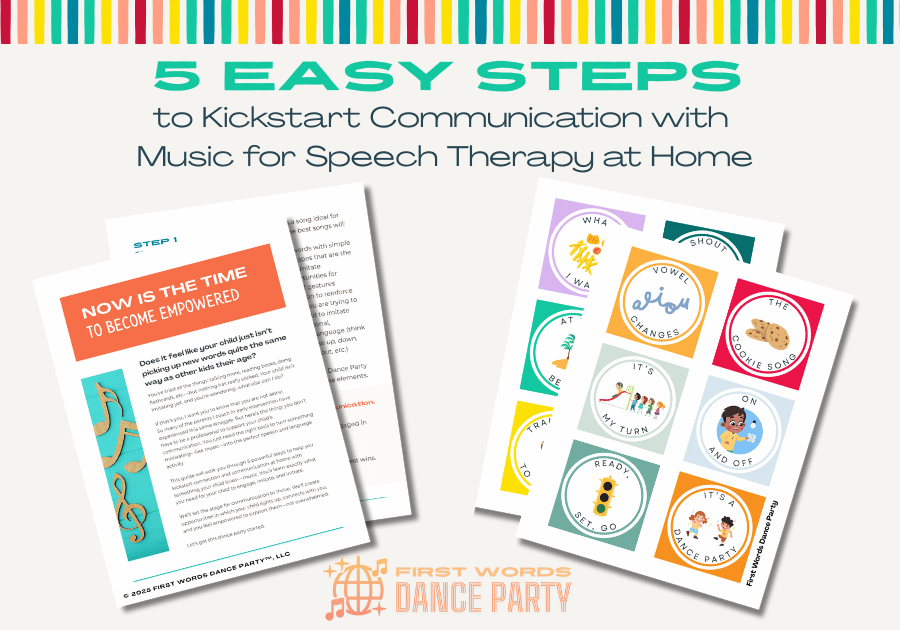Have you ever wondered if your late talker is actually a gestalt language processor?
If your child has a speech delay, and yet they sometimes repeat phrases from favorite shows or songs, you may have wondered how they can repeat entire phrases yet struggle to communicate with single words.
If this sounds familiar, your child might be a gestalt language learner—and that is not only okay, it’s a powerful and valid way to develop language.
As an early interventionist, I’ve supported many children with this style of communication and their parents. But I’ll be the first to admit—I didn’t always recognize the brilliance of gestalt language processing. I wondered why the typical, go-to strategies I'd use with other children with language delays weren't working. Since those early days, I've learned so much.
If your child isn’t using many words yet, you may be unsure of what to do and what not to do- and you’re not alone. Many parents I coach in early intervention feel stuck, frustrated, or overwhelmed when their child won’t imitate their words.
That’s why I started creating music for speech therapy that weaves in strategies for children who are gestalt language processors.
You can download a free guide to discover 5 easy, parent-friendly steps to use songs for speech therapy to spark connection and communication with your child. As a bonus, you’ll receive song boards with cards for every First Words Dance Party™ song, so your child can make choices and initiate.
Alright, let's get into how to know if your child is a gestalt language processor.
Back in the day, before I understood how to spot a gestalt language processor…
Fresh out of college, I was working with a two-year-old who wasn’t yet saying any words. One day, I entered their home for a session and the little boy’s mom was excited to share that over the weekend, he had said not only his first word, but his first three words: “Swiper, no swiping!”.
Note: to anyone reading this who isn’t approaching 40 and continuously finding gray hairs like I am, “Swiper, no swiping” is a line from a popular kids’ show Dora the Explorer from the 2010’s.
At the time, I thought of this script as echolalia and didn’t give it much more thought. Insert facepalm here.
When we fail to identify a child as a gestalt language processor, we miss out on opportunities for communication
What a missed opportunity that was!
I didn’t yet understand what he was communicating with this script. I didn’t yet get that he was using a well-known and meaningful phrase that was rooted in a personally emotional experience.
It wasn’t until I read “Uniquely Human” by Barry Prizant about five years later that my entire understanding of echolalia shifted.
Now, looking back, it’s clear to me that this sweet little boy was a gestalt language processor- and that phrase was his first bridge into language.
Thankfully, now I have a much better understanding of how to teach gestalt language learners and how to use this learning style to play to a child’s strengths.
What Is Gestalt Language Processing?
Children who are gestalt language processors (GLPs) learn language in chunks—called “gestalts”—rather than building it word by word. Gestalts often come from songs, shows, or familiar phrases like “wait for mommy” or “clean up, clean up”.
Over time, children begin breaking those chunks apart and creating their own original combinations.
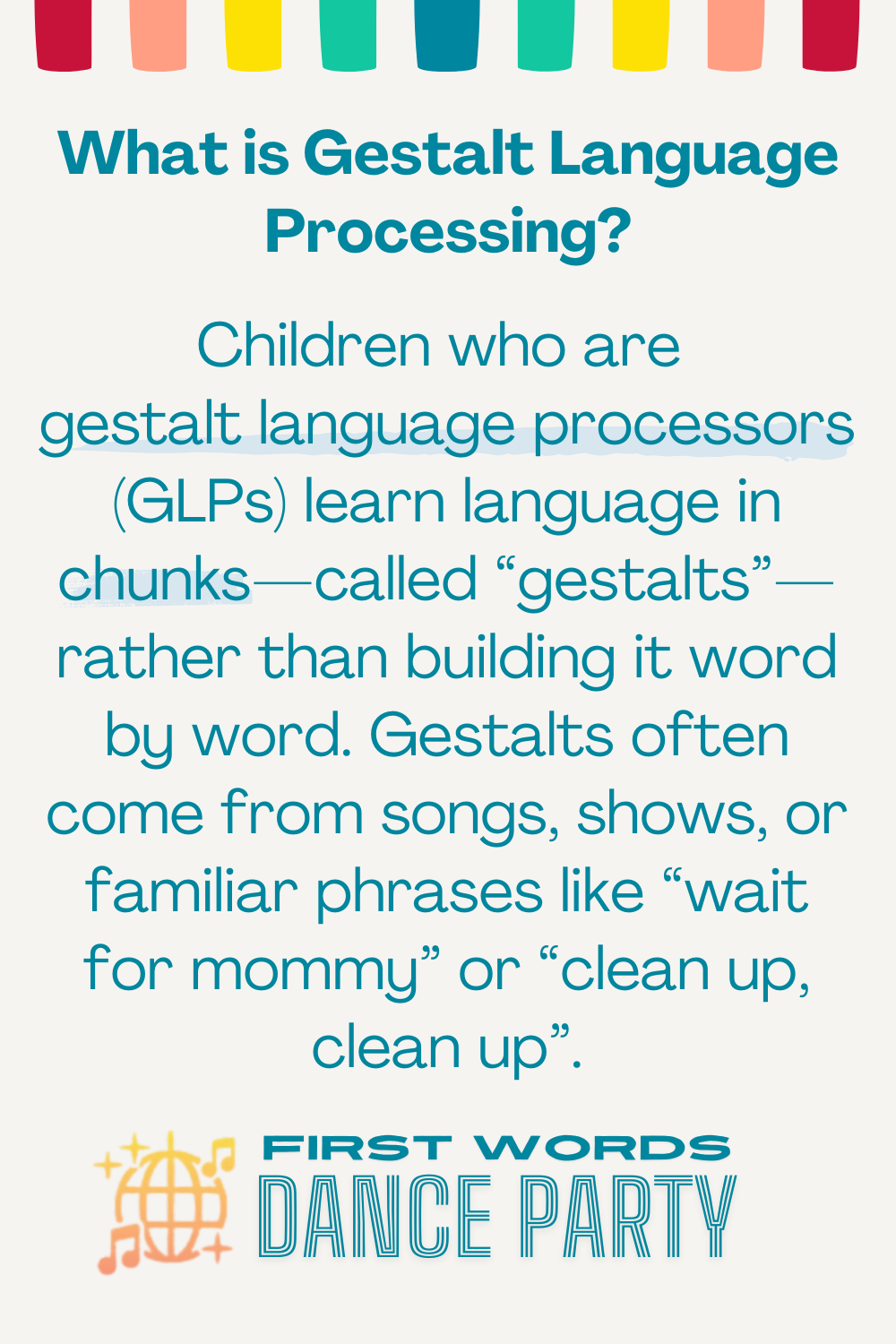
Gestalt Language Processing vs. Analytic Language Processing
The GLP learning style of processing language in whole chunks is different from that of analytic language processors, who typically begin with single words (“milk,” “go,” “up”) and gradually combine them into short phrases and sentences.
Analytic language processing describes the more typical learning style that little ones tend to use as they gradually add first words to their vocabularies, one word at a time. You can check out these articles on Receptive Language and 5 Easy Ways to Boost Language for more information and strategies for kiddos with speech delays who follow this learning style.
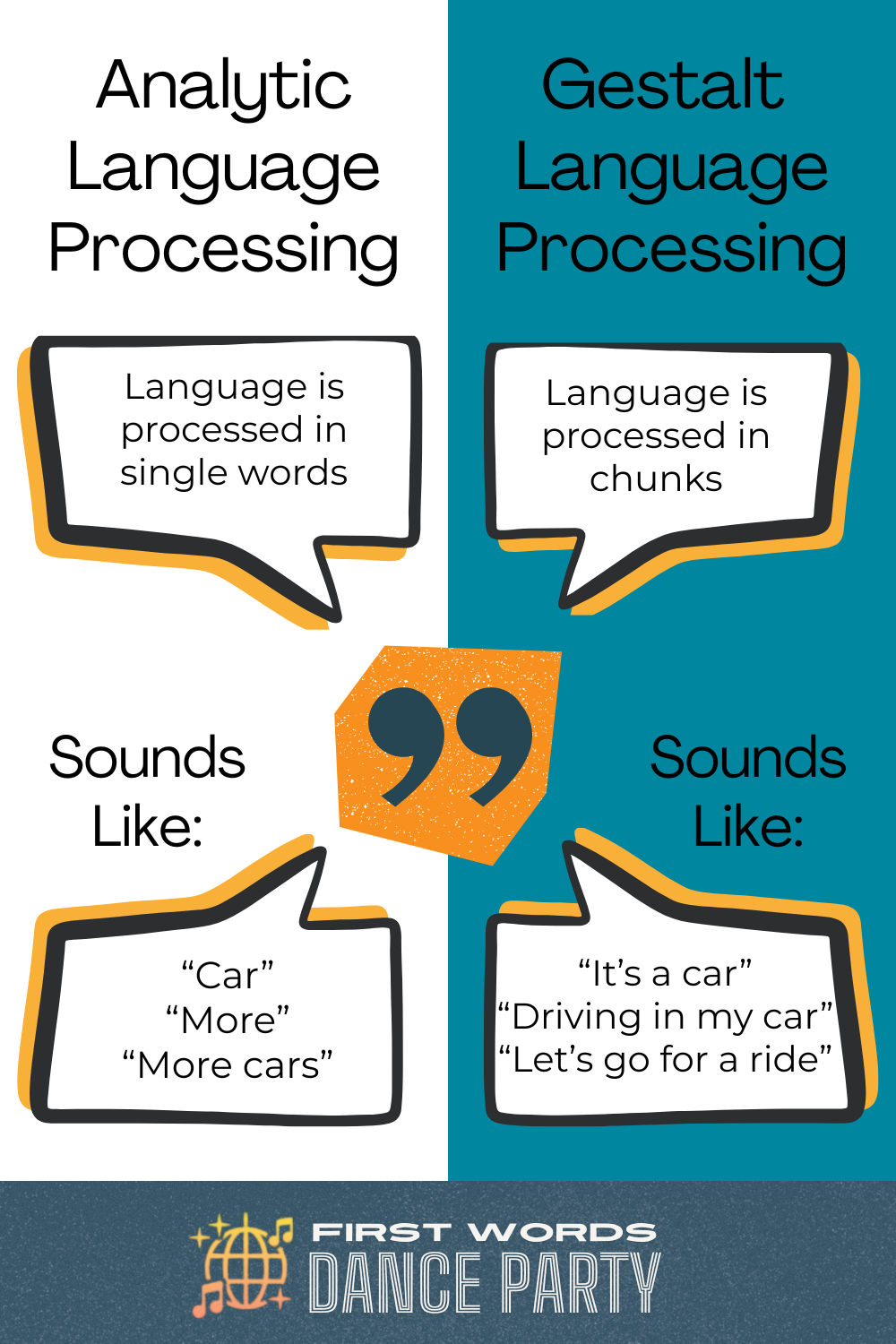
Is analytic language processing better than gestalt language processing?
Both language processing styles are valid. One isn’t better than the other—they’re just different paths to meaningful communication.
Analytic language processing is considered to be the "standard" path to language. It is generally better understood than gestalt language processing, which is relatively new in terms of research.
As awareness of gestalt language processing increases, though, early interventionists like myself are hungry for resources to support these learners to reach their full potential.
Read this if you’re wondering, “What is a gestalt language processor?”
Here are some clear indicators to look for if you’re wondering if your child is a gestalt language learner.
Gestalt language processors use scripted phrases before single words
If you find it difficult to count how many individual words your child says because they tend to use those words primarily within the same predictable phrases, you may be raising a gestalt language learner.
Let’s say, for example, that your child tends to say, “Open Shut Them, Open Shut Them” (from the fingerplay song), but they don’t yet consistently use the single word “open” to ask you to open a snack or a door.
The phrase “Open Shut Them” would be considered a script, or a gestalt. That whole phrase carries meaning for the child- not the individual words within the phrase.
A gestalt language learner will echo lines from songs
Above, I used an example of a gestalt from a popular fingerplay song. Reciting phrases or even longer lines from songs is very common among gestalt language processors.
This is because GLPs tune in to the intonation and melodic nature of language. Songs are often some of the very first scripts that GLPs begin to use.
💡 This graphic is getting tons of love on Pinterest!
👉 Click here to save it so you can come back to it anytime.
They echo lines from shows or conversations
Gestalt language learners often repeat lines from their favorite shows. Sometimes it’s pretty easy to figure out the meaning behind the gestalt, because it fits the context of the situation so cleanly.
For example, a GLP who has picked up the phrase, “This is trifficult!” from Bluey and says it while trying to use child-safe scissors may be communicating, “This is hard!”.
Other gestalts are not so straightforward and require us to play detective. Certain lines from shows, songs, and real-life conversations stick with GLP’s because of the emotions they experienced at the time they heard the line.
It is often the emotional experience, rather than the literal meaning of the words, that carries the meaning for Gestalt Language Processors.
Remember before when I mentioned the little boy I worked with who repeated “Swiper, no swiping!” from Dora the Explorer? Around the same time that he began echoing that line, he had started to counter surf- literally climbing up and walking on the countertops to look for snacks in the cupboards.
This happened multiple times per day, each time with his mom kindly but firmly setting limits and putting him back on the ground.
My best guess is that he connected, “Swiper, no swiping!” with the emotional experience of getting caught taking things you’re not supposed to. So then, when his mom would tell him no or that it was time to get down from the counter, he responded with, “Swiper, no swiping!”.
Gestalts can take some time to figure out. Hindsight is 20/20. I’m just bummed out that I didn’t realize the beauty behind his gestalts back at that point in my career.

Developmental milestones look different
If you’ve looked at milestone charts, you might have felt confused or worried. Milestone charts are based on analytic language processing—and gestalt language learners don’t always follow that same timeline.
Gestalt language processors not only use language in chunks, they understand it in chunks. These kiddos often struggle to recognize a word as a single unit.
For this reason, milestones like recognizing the names of common objects, following simple directions, and responding to questions follow a different timeline.

Gestalt language learners use long, melodic strings of sounds
GLPs are keenly aware of the melodic, intonational nature of language. Once they start vocalizing, they will often speak in long, unintelligible (not understandable) strings of sounds.
These strings are rich in intonation that rises and falls just like conversational speech or the melody of a song. Their strings of sounds may not always be clearly understood, but they do sound like something. That musicality isn’t random—it reflects the prosody of the original phrase they heard.
If we listen closely enough, we may notice patterns. Perhaps the child produces that same string of sounds with that same intonation whenever they play with a certain toy, or during a specific routine, like getting into the bathtub.
We might notice that the long string of sounds sounds like the theme song from a favorite show. We might pick up on one or two intelligible words within that long string of sounds and have an “aha moment” when we realize where that line is coming from.
Real-life gestalt language processing examples from toddlers and preschoolers
Here are some real gestalt language examples from kids I’ve worked with over the past year. Their parents and caregivers were absolutely phenomenal at doing the detective work to figure out what their toddlers were trying to tell them with their gestalts.
“Brush your teeth.” This was one little girl’s way of letting her parents know that she wanted to go upstairs and begin the nighttime routine. She loved her shower and toothbrushing.
“Tyrannosaurus Rex!” For this sweet little girl, this gestalt signaled that she was scared of or surprised by something. There usually weren’t any toy dinosaurs or pictures of dinosaurs when she said it, so it took some time to figure this one out. She said this when something surprised her, and she usually had a very surprised or nervous/scared facial expression when she said it.
“Be careful!” One kiddo I worked with started to say this phrase at the end of every school day as she got her backpack on. This one required detective work, too. The bus driver would actually say this to her every time she climbed the big bus stairs. So, “be careful” was this was this little girl’s way of saying, “We’re on our way to the bus now.” So cool, right?
-
“Yeah! It’s a car!”. This sweet little guy loves Mickey Mouse, and his mom shared that this is where he heard it. The meaning behind this gestalt is pretty easy to figure out, because he says it when he takes a toy car and gives it to someone. This gestalt could be taken literally, but he could also mean something closely related along the lines of, “let’s play with cars”.
Scripts can’t always be taken literally
At first, these gestalts, or scripts, might seem very out of place. Most can’t really be taken literally.
But when you look at the emotion and the experience behind the script, everything changes. These scripts are these kiddos’ attempts to use language to signal a feeling, an emotional experience, and to share thoughts and desires.
Let’s clear this up: misconceptions about gestalt language processing
“But isn’t that just echolalia?”
Yes—but echolalia is not just meaningless repetition. It’s a gestalt language processor’s way of processing, storing, and eventually transforming language.“But isn’t that just stimming?”
Scripts are not empty stimming to achieve a sensory experience. They’re symbols of lived experience. That exact phrasing and intonation means something to a GLP—and often, it’s the most effective way they have to communicate in that moment.
By recognizing these points, we can stop trying to “break” a child’s scripts and instead build bridges to the next stage of communication.
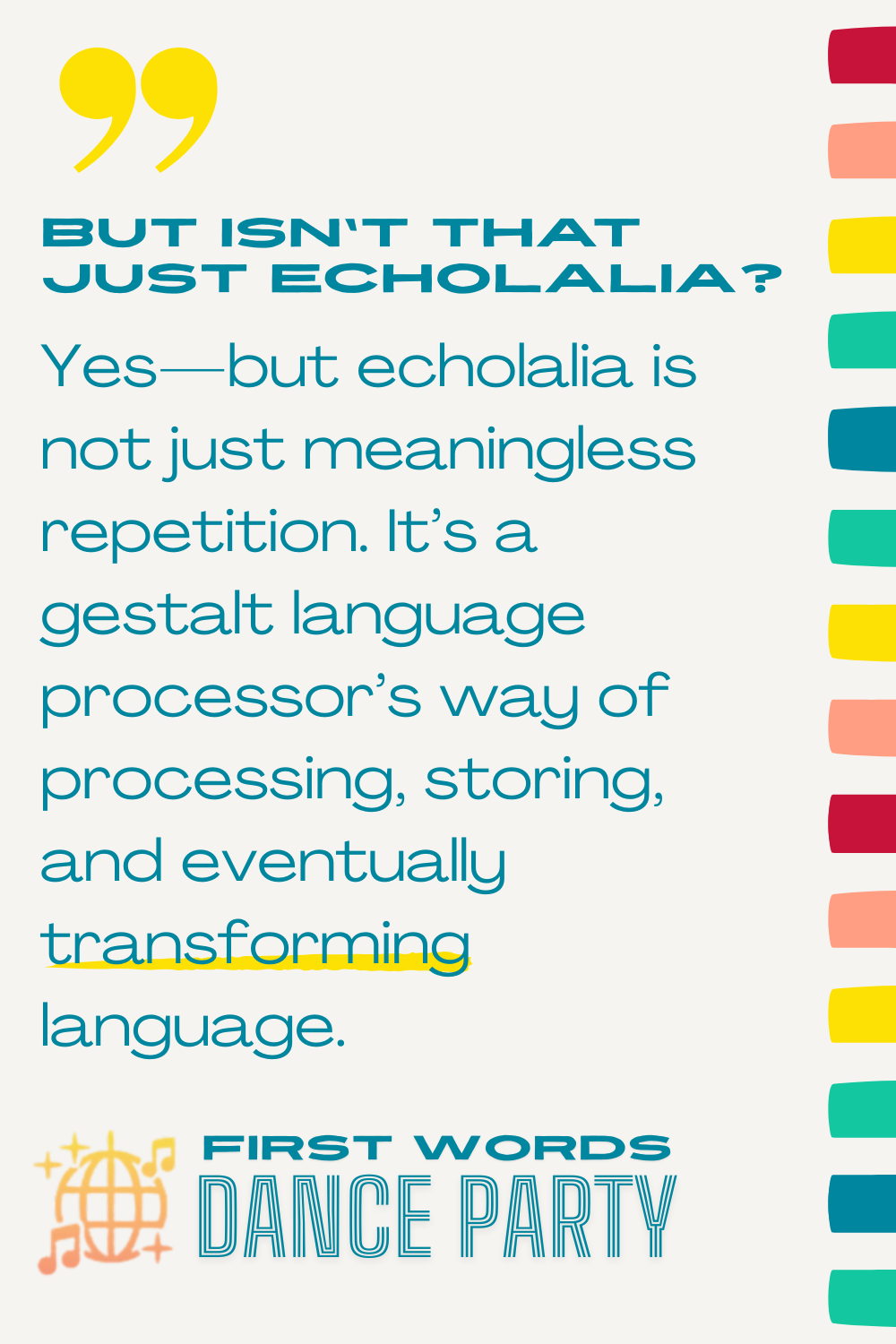
More information for parents and caregivers wondering how to teach gestalt language learners
Here are some resources I highly recommend for parents looking for ways to support their gestalt language learners.
Natural Language Acquisition on the Autism Spectrum by Marge Blanc
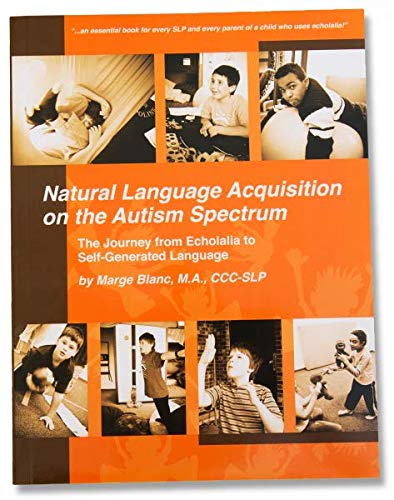
Natural Language Acquisition is a framework that explains how gestalt language processors develop and use language.
Blanc outlines gestalt language processing stages in her book, guiding families from those early scripts toward more flexible, self-generated speech. It’s a compassionate, research-informed way to nurture real communication by meeting your child where they are.
The Gestalt Language Processing Handbook, by Kathryn Arnold of Meaningful Speech
This handbook is a practical, easy-to-read guide for parents and professionals supporting gestalt language processors. It breaks down the stages of Natural Language Acquisition in clear, relatable terms and offers concrete strategies for gestalt language processing treatment.
With clear examples, visuals, handouts, and a compassionate tone, the handbook helps caregivers recognize and respond to their child’s script and emerging language. The handbook is available for download through the Meaningful Speech website and often accompanies their online course. You'll also find a free masterclass to get you started.
Interested in finding a speech-language pathologist trained in natural language acquisition for your child? Look no further than their NLA trained clinician registry!
Uniquely Human by Dr. Barry Prizant
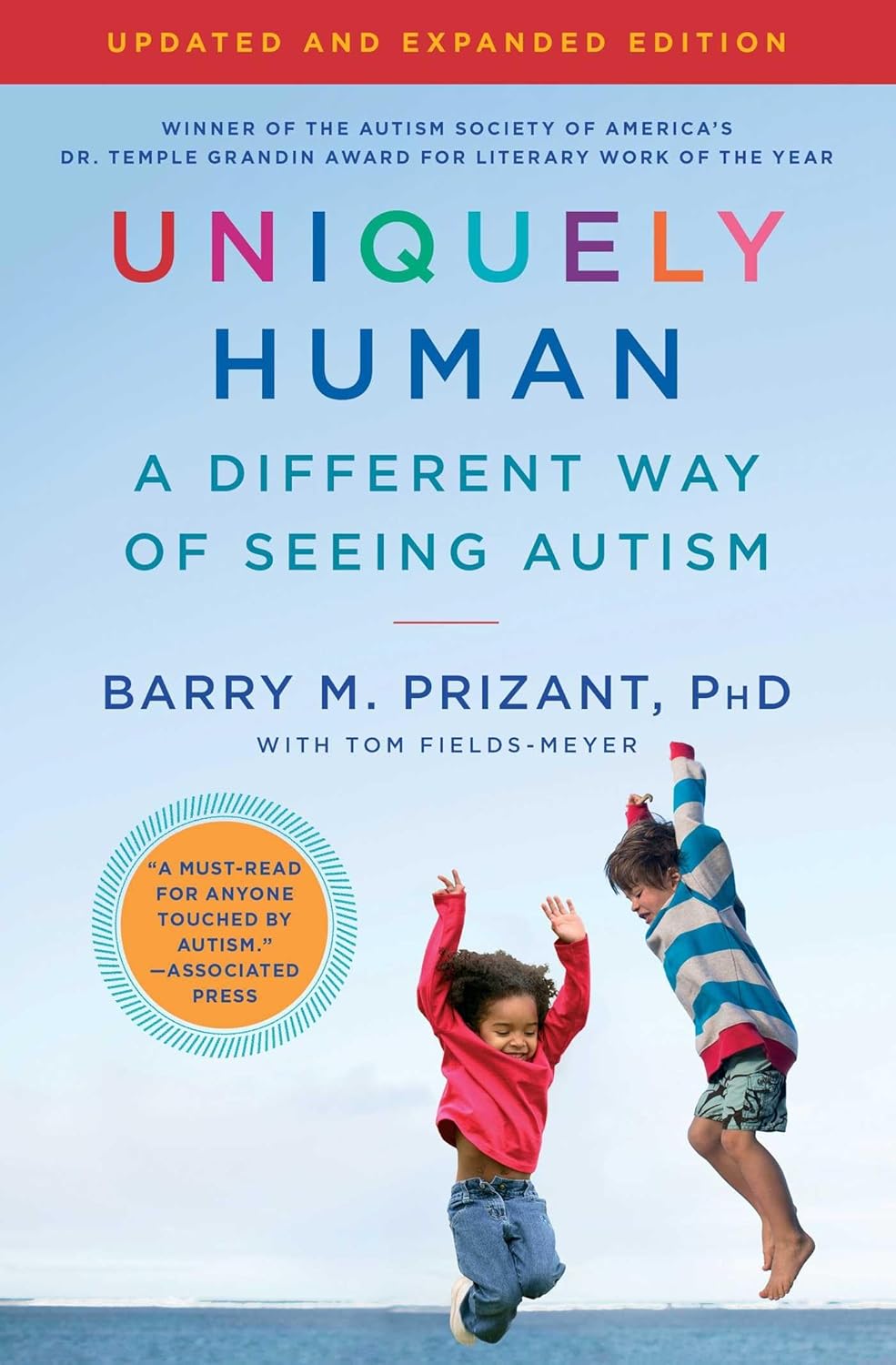
I’m not exaggerating when I say that reading this book changed my entire perspective on echolalia. While not about gestalt language processing exclusively, this book offers a refreshing and hopeful perspective on autism, emphasizing understanding over "fixing."
Rather than focusing on changing behaviors, Prizant encourages parents to see those behaviors as meaningful ways that children are coping, communicating, and navigating the world. Prizant interviews several adults who are on the autism spectrum in this book, and these are voices that neurotypical individuals really need to hear. It’s a deeply affirming read that reminds parents their child’s unique way of being is not something to fear—but something to understand and embrace.
First Words Dance Party: Catchy Songs and Music Videos for Gestalt Language Processors
First Words Dance Party is a fun, catchy collection of songs designed to support early language development. Each song models core vocabulary and words of the simplest syllable shapes, making the songs a powerful tool to help little ones imitate.
What makes First Words Dance Party especially helpful for gestalt language processors is the way each song is rich with naturally embedded scripts and phrases.
For children who learn language in chunks, not just words, the music provides ready-made phrases like “I need help”, “open please”, and “It’s my turn”- that can be repeated, generalized, and eventually transformed into more flexible speech.
Here are a few examples:
“The Cookie Song”: A kid favorite that models the words yes and no with lots of repetition and rhythm, along with the phrases "I wanna eat", "I'm hungry", "Let's eat, please"
"It's My Turn": A super catchy parent favorite. This fun song about sharing helps little ones learn the words necessary to ask others for a turn.
“What I Want”: This one targets phrases to self-advocate, like "I want to go outside", "open the door", "I want to eat chicken nuggets", and "I want water, please". Check out the core word video below to see how you can model AAC along with the songs. (Note that this core video YouTube series does highlight core words at the individual word level, versus using one symbol to represent an entire phrase
You can stream First Words Dance Party on Spotify, YouTube Music, Apple Music, and anywhere else you get your music.
Exclusive Upcoming Video Series
Ever feel like your child imitates things they see in videos, but it's almost impossible to get them to imitate you?
You're not alone. I can't tell you how many kiddos I've worked with who struggle to imitate, but there's something about watching a video that works some sort of magic.
It's what inspired me to create a brand new series of music videos that incorporate video modeling, AAC (Augmentative and Alternative Communication), and so much more.
Now, your child can experience the rhythmic, melodic gestalts in the songs as those scripts come alive with video modeling of real children engaging in real, daily routines.
This exclusive 10-video series brings each First Words Dance Party song to life with:
✅ Real children modeling language through daily routines like meals, playing with toys, and going to the playground
✅ Functional core words expressed through AAC, gestures, and sign language
✅ Aided language stimulation timed perfectly with the music
✅ Videos created specifically for gestalt language processors and children with speech delays
Unlike our free YouTube videos, these go far beyond lyrics. They show the "how"—how to use music to support expressive language, how to carry core words into real life, and how to use AAC to make language visible and accessible.
All in time with the lyrics of each song.
So you can experience the joy that comes with hearing your child say "up" and "help" for the first time. So your child can discover the power of their actions and their voice when you ask if they're hungry and they nod their head "yes".
Be the very first to know when the doors are opening by joining the waitlist.
A unique and fascinating path to language
Gestalt language learners have a unique and fascinating way of processing language.
While different from the more common, word-by-word processing style of analytical language learners, gestalt language processing is a natural and meaningful way to develop language.
If the indicators in this article sound like your child, you may be raising a gestalt language processor- and you’re taking the first step toward better understanding your child.
Don't forget to grab your 5 Easy Steps to Kickstart Communication with Music for Speech Therapy at Home to take the first step toward connection and communication with your kiddo.
You don’t need to rush or “fix” anything. Your gestalt language processor is learning to speak in their own way—and you’re learning how to listen.
